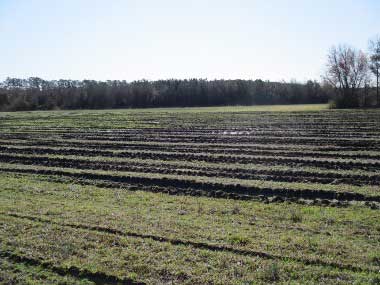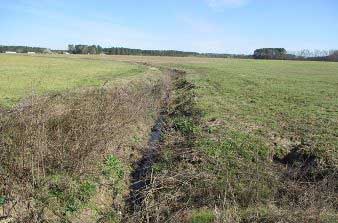By Sarah Padyk
 Barbara Doll’s passion for protecting and improving the environment has shaped her career as an engineer. Now, as a professor and researcher at North Carolina State University, she’s combined her engineering expertise and experience in ecosystem restoration to analyze green infrastructure solutions that could increase flood resiliency in North Carolina.
Barbara Doll’s passion for protecting and improving the environment has shaped her career as an engineer. Now, as a professor and researcher at North Carolina State University, she’s combined her engineering expertise and experience in ecosystem restoration to analyze green infrastructure solutions that could increase flood resiliency in North Carolina.
Doll grew up on an island in Eastern North Carolina, and her time living on the sound shaped her interest in water and water management practices. A talent for math and encouragement from her family drove her to complete a bachelor’s degree in civil engineering at NC State and begin working at an engineering firm. However, she quickly realized she wanted to pivot her career to focus on the environment. After completing her master’s degree, Doll took a job with North Carolina Sea Grant, setting her on a path to water-based work.

Doll has enjoyed her work so much that she is still in this position today. She completed a doctorate at NC State while working full-time for North Carolina Sea Grant. She became a faculty member at NC State in 2014. She said that the constantly evolving issues and opportunities at the university were why she became so passionate about this work.
“I really like going out and meeting with communities and engineers and learning about what they’re doing and what their needs are,” Doll said. “I can then take information from the University that is very applied and help engineers improve their designs to be more beneficial for the environment or help communities be more resilient or sustainable in cost-effective ways.”
Through this role, she began her Collaboratory-funded research focused on a multidimensional analysis of green infrastructure in North Carolina to reduce downstream flooding. The work examined potential green infrastructure impacts on flow reductions and flood resiliency in the Middle Neuse River Basin, simultaneously analyzing specific areas where these practices may be feasible.
“All my research is very applied, which is why I love the Collaboratory,” Doll said. “They want answers to direct questions that our state, our regulators, and our elected officials need to know…”
Doll led a team of more than 20 students, professionals, and faculty from NC State and UNC-Chapel Hill to take the research a step further by broadening their lens. The team also performed cost analyses on mock designs of potential infrastructure and went into communities, speaking with landowners to see how accepting they would be of these projects. Doll said that the goal was to look at the numbers from the landowner’s perspective to the state’s perspective.
“All my research is very applied, which is why I love the Collaboratory,” Doll said. “They want answers to direct questions that our state, our regulators, and our elected officials need to know in order to make good decisions with policy and appropriations. So, I can’t think of a better place to do this work because water environments are so critical to our state.”
Doll and her team’s research revealed the potential for nutrient and sediment reduction and increased flood mitigation by implementing these designs in the basin. She said the findings showed these distributed practices would be a good approach and provide benefits, paired best with the continuing work to keep the main river system’s floodplain clear.
“This needs to be a place for people and a place for water,” said Doll. “We saw some very positive things about what natural infrastructure could do, especially surrounding flood storage, wetlands, and reforestation.”

Over the years, Doll’s interdisciplinary perspective on flood mitigation has connected her with organizations beyond NC Sea Grant and the North Carolina Collaboratory. The Environmental Defense Fund (EDF) has also aided and co-funded Doll’s research on flood mitigation and watersheds across the State. Will McDow, Director of Climate Resilient Coasts and Watersheds at EDF, has worked with Doll since 2019 and served as an advisor on her natural infrastructure solutions research. He has been continually impressed by Doll, and views her as an invaluable expert on flood modeling and its relations to policy and project implementation.
“It was an incredible example of a multidisciplinary, multi-institution study exploring an important and timely issue for the State,” said McDow. The various papers and chapters of that study continue to be useful for policymakers and local watershed efforts.”
Doll is excited by the North Carolina General Assembly’s interest in this research, and noted, “Our legislature has taken this very seriously. This is big. It impacts a lot of people. I’m just really glad they’re funding this kind of work and listening to what comes out of it.”
Moving forward, Doll is excited to build on this research and continue her relationship with the Collaboratory as she works to generate solutions that impact people in North Carolina.
“We have a beautiful state,” said Doll. We have amazing, diverse resources from the mountains to the sea, and this is where I work. So, to be doing this work with the Collaboratory, I just can’t think of a better place. I think the potential for it to lead to real change is there.”
Sarah Padyk is a graduate student at the UNC-Chapel Hill Hussman School of Journalism and Media and is an environment and science communication dual degree student. She graduated with a BS in environmental science from UNC-Chapel Hill in May and is currently working towards an MA in media and communication. She is a communications intern with the Collaboratory for the 2022-23 academic year.
